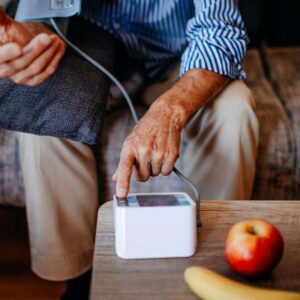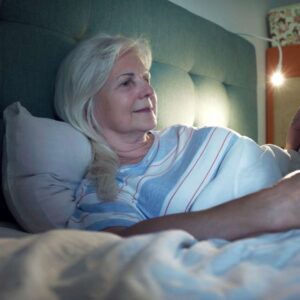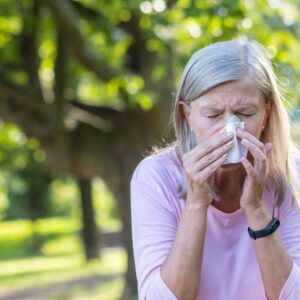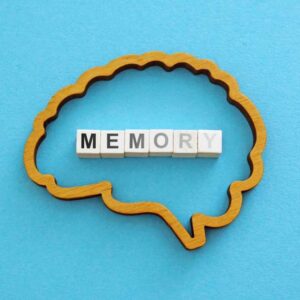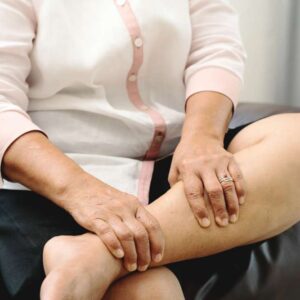
Increase Sleep and Reduce Anxiety With This Special Blanket
- Don’t go to bed with Big Pharma! Discover how this breakthrough blanket maybe just as effective as prescription drugs
- Perfect pressure can lead to calmer nights. Find out more…
- One ways to tuck yourself in for better sleep and lowered anxiety today!
Dear Living Well Daily Reader,
“Go get one of those new blankets off the linen cart, please. This patient really needs one. Oh, and take a friend. You’re going to need some help…”
A few years ago while working as a social worker, I filled in for a co-worker on the memory disorder unit. During my shift, we got a very agitated admission. This patient was anxious, combative and very confused.
In fact, on the night of her admission, she had become so violent at the nursing home where she lived she was placed in restraints so she could be transported safely to the hospital. But she never calmed down — not in the emergency room or on our unit. Well, not until she was tucked in under one of those new blankets.
You see, the charge nurse told me I needed a partner to get one of these new blankets because they were heavy. And not the kind of heavy meant for cold weather. These blankets weighed about 20 pounds each. But it wasn’t just their weight that was so shocking about them.
It was also the way this heavy blanket calmed the agitated patient very quickly. Actually, it kept her calm for most of her stay.
![]() Weighted Relief
Weighted Relief
This special blanket is called a “weighted blanket.” Weighted blankets typically use plastic or tiny glass pellets that are sewn into compartments. These compartments ensure that the weight is consistent throughout the blanket.
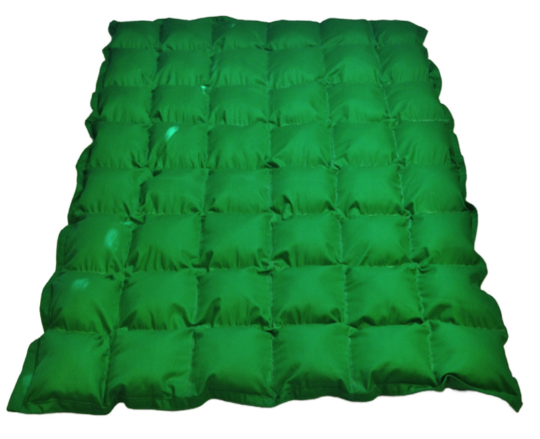
Weighted blankets can provide relief from a variety of debilitating disorders (we will get deeper into these in just a bit) without the use of pharmaceuticals. Plus, they are relatively cheap when compared with the costs of drugs and have few side effects.
These special blankets seem to work just as well as painstakingly designed and researched drugs because they tap into something humans have used to induce calm since the start of our existence — being held.
Studies indicate that stimulating certain pressure points on the body can release serotonin, the chemical that helps regulate brain functions like mood and sleep. This is why the feeling of being held is so important.
Native Americans famously transferred this idea into a practice called swaddling. Many hospitals, birthing centers and parents continue the practice today. In fact, just a few days ago, I watched a close friend swaddle his 3-week-old fussy daughter. In about two minutes, she was much calmer (and more receptive to me holding her).
[Ed note: I should mention that swaddling and weighted blankets can cause suffocation if not used with proper technique. Be sure to ask a health care professional if swaddling or weighted blankets are appropriate for your loved one before starting this practice.]
Internationally renowned autism authority and livestock researcher Dr. Temple Grandin explains why this pressure can change behavior quickly:
Light touch pressure is a more superficial stimulation of the skin, such as tickling, very light touch or moving hairs on the skin. In animals, the tickle of a fly landing on the skin may cause a cow to kick, but the firm touch of the farmer’s hands quiets her. Occupational therapists have observed that a very light touch alerts the nervous system, but deep pressure is relaxing and calming.
![]() Better Sleep, Less Anxiety
Better Sleep, Less Anxiety
But as my aforementioned example with my dementia patient proves, this kind of pressure provides comfort not just for babies and children. Studies have found that weighted blankets may have health benefits for other folks as well.
A study found that using a weighted blanket reduced the anxiety levels in 63 percent of the participants. This claim has been since supported by other papers.
Another study with participants who suffered from stress, pain and sleep issues showed that that when the subjects slept with weighted blankets, they experienced a reduction in cortisol. Reducing cortisol, which is the main stress hormone, can lead to better overall sleep quality.
In addition, weighted blankets have benefited folks with a variety of anxiety disorders, aggression, obsessive-compulsive disorder, ADHD and post-traumatic stress disorder with zero risk. This means, this simple blanket could be a better solution than mind-numbing psychotropic pharmaceuticals for many folks.
We had these blankets for six months on our geriatric and adult inpatient mental health units, and they were truly amazing. I saw how quickly these blankets could soothe an agitated or anxious patient. In fact, many of them would wrap themselves in the blankets during seated activities.
Unfortunately, we had these blankets only as part of a pilot program, and they were taken from both units. And even though most of the staff begged for their return, our director didn’t see their merit and blamed “budgetary” reasons for not purchasing more. The nights that followed were difficult for patients who had grown accustomed to the feeling of being “grounded” during sleep.
However, the staff continued to recommend them for to patients and families. And to our relief, many of them found weighted blankets to be a helpful addition to their health protocol.
If you’re interested in having a weighted blanket of your own, you can make one. Click here for a tutorial. The rule of thumb when selecting the appropriate weight is 10 percent of one’s body weight plus 1 pound.
If DIY isn’t your thing you can order one from Sensory Goods.
Click here to check out their selection of weighted blankets.
Live well,

Natalie Moore
Managing editor, Living Well Daily
Sources
[1] Take the load off with Weighted Blankets
[2] How Weighted Blanket Therapy Can Help Those With Anxiety, Autism, And More
[4] Sleeping With Weighted Blanket Helps Insomnia And Anxiety, Study Finds
Written By Natalie Moore
Natalie Moore is a dedicated health researcher with a passion for finding healthy, natural, and science-based solutions. After a decade of direct healthcare experience in western and natural medicine, she was involved in public health research before joining Living Well Daily.
View More Free Articles
The 5 Health Numbers Your Doctor Wishes You'd Track
Have you ever been told you should “advocate” for yourself when it comes to your healthcare and wondered what that really means? It’s not just a buzzword—it’s a powerful concept that empowers you to take charge of your own health journey. In fact, it could save your life. Being your own best health advocate starts...
Do THIS Every 20 Minutes to STOP Digital Eye Strain
Our eyes are under assault—they are the true victims of our current digital age. And it’s because we are constantly glued to screens… phones, tablets, computers, TVs—you name it. Unfortunately, that screen time is taking a serious toll. Digital eye strain affects millions worldwide. In fact, up to 50 percent of computer users could develop...
Mailbag: The Calcium Mistake That's Hardening Your Arteries
“What type of calcium is best to take with bisphosphonates for osteoporosis? I know some varieties can build up in arteries. Thanks for the help.” —Bone Builder Hi Builder, When a patient asks me about calcium, I ask them a peculiar question in return… “Ever wonder how elephants and giraffes build and maintain their massive...
Doctor-Approved Method to Ditch Blood Pressure Meds
In a world where drug solutions dominate healthcare, it’s refreshing to discover that best remedies sometimes don’t involve a single pill. A groundbreaking study shows simple relaxation techniques could be your secret weapon against one of America’s deadliest health conditions. Best of all? It’s free, easy to start right away—and your results are bound to...
Trouble Hearing? Your Heart Could Be at Risk
With research exploding and data pouring in, scientists are uncovering some weird (and surprisingly helpful) health connections. Today’s odd couple? Hearing loss and heart failure. Turns out your ears and your ticker are more connected than you ever imagined. A major study published in the journal Heart looked at over 164,000 people for nearly a...
Stay Up Late? It Could Destroy Your Mental Health
If you dread mornings but come alive at night, there’s concerning new research you need to know about. A recent study found that “night owls” are at higher risk for depression. But before you rush to set your alarm to get up with the sun tomorrow, there’s more to the story… Chronotypes are essentially your...
Go from Flabby to Fit with this Common Vitamin
If you’re like many of us, you woke up one day, looked in the mirror, and realized you’re no spring chicken anymore. Even worse—when you weren’t paying attention—it seems you somehow misplaced the muscles of your youth and have gone from fit to flabby. Aging has a way of humbling us like that. But scientists...
Seasonal Allergy “Off Switch” Discovered in the GUT
“Doc, why am I suddenly suffering from seasonal allergies when I’ve never had them before?” It’s a question I get all the time—and my answer might surprise you. Stop looking up at the trees—and start looking down at your gut… Your sneezing fits, itchy eyes, and runny nose might have more to do with what’s...
“Canary in the Coal Mine” Test Sniffs Out Brain Issues Early
One of the most common questions I get is how to tell if you’re starting to experience cognitive decline. I get it—losing your memory is scary, especially when it sneaks up on you. But here’s some exciting news that might put your mind at ease. A fascinating new study suggests that your nose might be...
BEAT Stubborn Leg Swelling Without Dangerous Diuretics
“I need help with edema.” —Swollen Hi Swollen, When patients complain of edema—fluid retention that causes feet, ankles, and legs to swell—I explain that, while conventional medicine immediately prescribes diuretic drugs, nature offers us effective solutions we can try first. I’ll share those in just a moment, but first, let’s take a quick look at...
